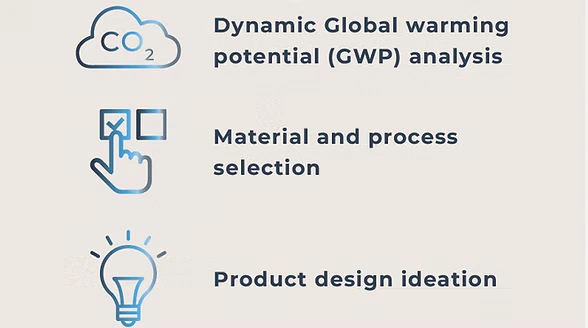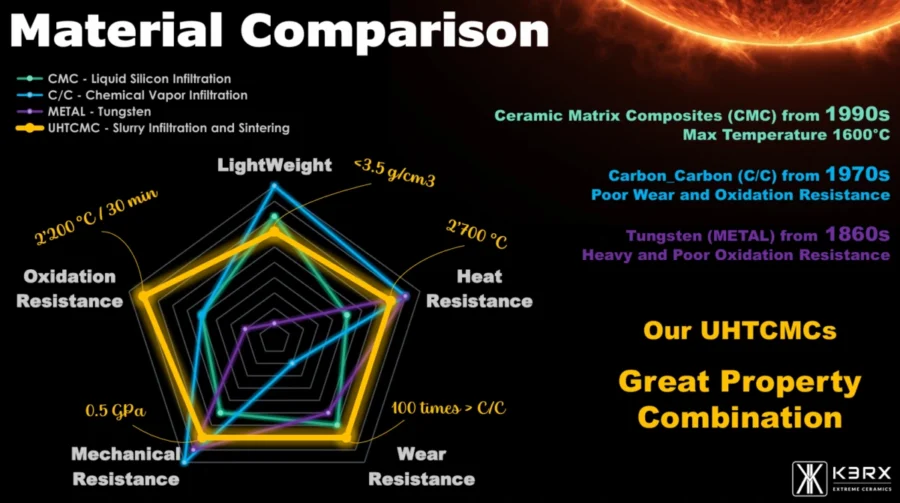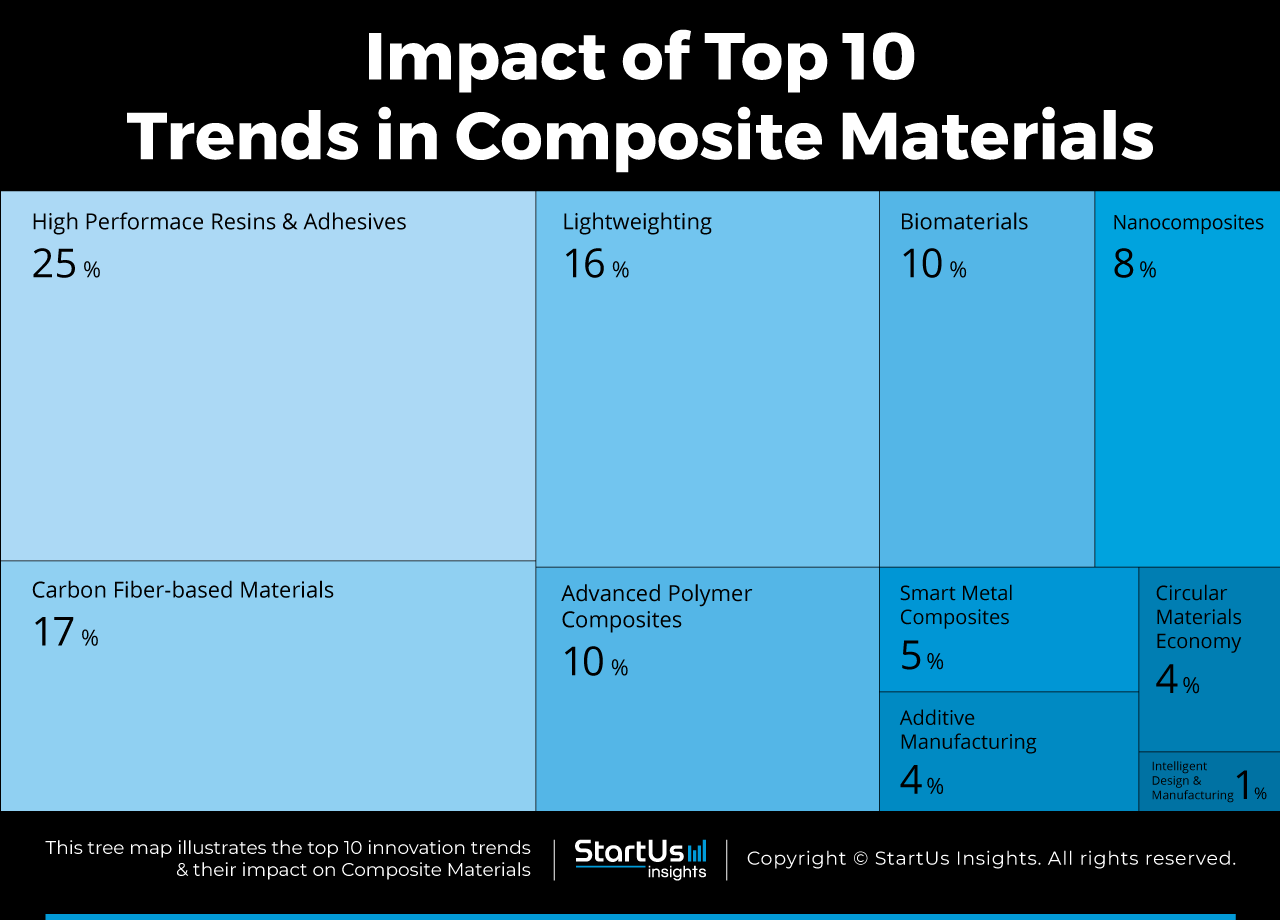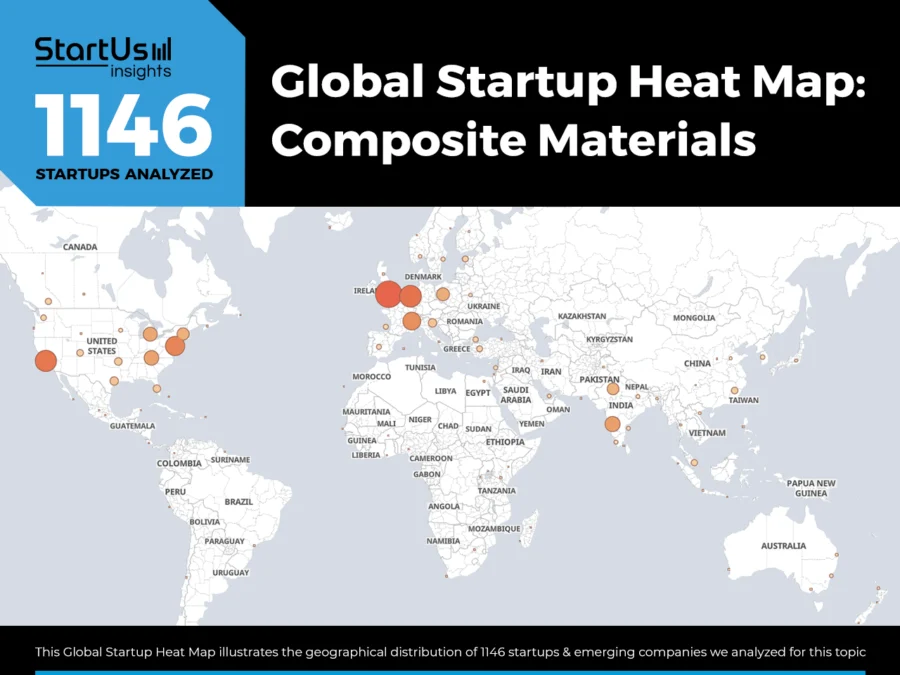Accelerate Productivity in 2025
Reignite Growth Despite the Global Slowdown
Having become an integral part of industries, composites offer a combination of strength, lightweight properties, and versatility. However, challenges exist in the development and utilization of composites that meet specific industry requirements, such as enhanced performance, durability, and cost-effectiveness.
Innovations addressing these issues include advanced manufacturing techniques like robotic fiber placement and resin transfer molding, novel material formulations, and more.
This industry research focuses on the top 10 trends in 2composite materials based on our analysis of 1100+ companies. These trends promote greater sustainability and rapid adoption of composites in various industries.
What are the Top Composite Material Industry Trends in 2025?
- High Performace Resins & Adhesives
- Carbon Fiber-based Materials
- Lightweighting
- Advanced Polymer Composites
- Biomaterials
- Nanocomposites
- Smart Metal Composites
- Additive Manufacturing
- Circular Materials Economy
- Intelligent Design & Manufacturing
Methodology: How We Created the Composite Materials Trend Report
For our trend reports, we leverage our proprietary StartUs Insights Discovery Platform, covering 5M+ global startups, 20K technologies & trends plus 150M+ patents, news articles, and market reports.
Creating a report involves approximately 40 hours of analysis. We evaluate our own startup data and complement these insights with external research, including industry reports, news articles, and market analyses. This process enables us to identify the most impactful and innovative trends in the composite materials industry.
For each trend, we select two exemplary startups that meet the following criteria:
- Relevance: Their product, technology, or solution aligns with the trend.
- Founding Year: Established between 2020 and 2025.
- Company Size: A maximum of 200 employees.
- Location: Specific geographic considerations.
This approach ensures our reports provide reliable, actionable insights into the composite materials industry innovation ecosystem while highlighting startups driving technological advancements in the industry.
Innovation Map outlines the Top 10 Trends in Composite Materials & 20 Promising Startups
For this in-depth research on the Top Composite Materials Trends & Startups, we analyzed a sample of 1140+ global startups & scaleups. The Composite Materials Innovation Map created from this data-driven research helps you improve strategic decision-making by giving you a comprehensive overview of the Composite Materials industry trends & startups that impact your company.
Tree Map reveals the Impact of the Top 10 Composite Materials Trends in 2025
Top trends in the composite material industry include high-performance resins and adhesives, which are known for their bonding properties. Further, carbon fiber-based materials provide high strength-to-weight ratios. Advanced polymer composites improve mechanical properties and design flexibility along with lightweight which focuses on reducing weight while retaining mechanical properties.
Global Startup Heat Map covers Composite Materials Startups & Scaleups
The Global Startup Heat Map showcases the distribution of composite materials exemplary startups and scaleups analyzed using the StartUs Insights Discovery Platform. It highlights high startup activity in the Western Europe, followed by the USA, and India. From these, 20 promising startups are featured below, selected based on factors like founding year, location, and funding.
Want to Explore Composite Material Innovations & Trends?
Top 10 Emerging Composite Materials Industry Trends (2025)
1. High Performace Resins & Adhesives
A significant risk in materials for high-performance applications is the delamination and degradation of composite layers. This occurs when the bond between layers weakens and compromises the structural integrity. Innovations in high-performance resin and adhesives prevent this issue by providing stronger interfacial adhesion between composite layers.
It also incorporates toughening agents into materials and surfaces to improve the overall toughness and mitigate the risk of sudden failures.
Another issue in composites is their susceptibility to environmental factors such as moisture, heat, and chemicals, which degrades their mechanical properties over time. The use of high-performance resins and adhesives makes materials and surfaces resistant to these factors and offers improvements in durability and longevity for composites.

Credit: Consegic Business Intelligence
The Asia-Pacific region dominates the adhesive resin market with more than 38% share. Additionally, the global compound annual growth rate (CAGR) of resins and adhesives market is 16.40%.
SpeedPox manufactures Epoxy Composites
Austrian startup SpeedPox specializes in an ultra-fast curing system to produce epoxy composites with high performance, speed, and convenience. The startup’s hardener system allows the composites to cure rapidly at 120 degrees Celsius within seconds, eliminating the need for post-curing.
These epoxy composites have an extended shelf and work life of over six months, making them suitable for long-term storage. Moreover, these composites are non-toxic, highly durable, and provide faster throughput.
SpeedPox’s epoxy resins feature an endless pot life without mixing and curing on demand. This enhances productivity and efficiency in applications such as electronics, medical technology, and more.
Trimer Technologies provides Low Viscosity Resins
US-based startup Trimer Technologies offers thermosetting resins that enable high-volume manufacturing of composites with novel properties.
The startup’s range of resins includes RAPID for rapid curing, PARX which is flameproof and self-extinguishing, and N-FUZE for rapid infusion. Its N-SL8 supports high glass transition temperature and low thermal conductivity, the ARC line features high electrical resistance, and the PULL line ensures smooth continuous pultrusion production.
The cure rate and gel time are also adjustable to provide a long working life followed by a rapid cure with low exotherm, enabling cycle times under 60 seconds. Besides this, the startup’s resins enable resin transfer molding (RTM) manufacturing of composites suitable for applications requiring extreme FST performance.
2. Carbon Fiber-based Materials
Traditional materials may not possess the optimal balance of structural properties to meet the requirements of high-performance applications. Therefore, carbon fiber-based materials offer a replacement material with exceptional strength-to-weight ratios, allowing for lighter and more durable structures. They also exhibit excellent impact resistance and reduce the risk of hidden damage, enhancing the overall toughness of composites.
Further, composites often struggle with thermal conductivity and this limits their applications in high-temperature environments.
However, carbon-fiber-based materials possess superior thermal conductivity properties and dissipate heat efficiently, making them suitable for demanding thermal applications. As a result, carbon fiber-based materials find use in the automotive, motorsports, and aerospace industries, among others.

Credit: Grand View Research
Aerospace and wind energy are two segments where carbon fiber-based material is predominantly used currently. The aerospace sector accounted for the largest revenue share of 32.2% in 2024.
Eddytec advances Composite Defect Detection
Dutch startup Eddytec develops a sensing technique for defect detection in carbon fiber composites. Its sensing technique uses eddy currents to identify various defects in carbon fiber composites, a critical factor for their performance, durability, and sustainability.
This automated method reduces waste during composite manufacturing and decreases maintenance time in industries like aerospace. Eddytec’s solution positively impacts the manufacturing and maintenance of high-performance assets, equipment, and vehicles. This leads to higher-quality materials and extended product lifetimes.
Faradaynamics makes Anti-EMR Composites
Polish startup Faradaynamics specializes in special-purpose anti-EMR composites based on carbon fiber and Kevlar. Its composites consist of fibers such as carbon, kevlar, or glass, in combination with resins and special metal fibers which provide high strength.
Additionally, its composite structure creates a Faraday’s Cage-like housing around objects. Faradaynamics’ materials are customizable to meet strict material requirements and are supports complex shapes and designs. The startup’s composites find applications in surveillance electronics, military electronic devices, aviation instruments, industrial sensors, and medical equipment shields.
3. Lightweighting
The heaviness of materials with high mechanical properties limits their applications across industries like automotive and aerospace. To overcome this issue, materials producers are developing innovative composites like carbon fiber-reinforced polymers (CFRP) and foam core composites.

Credit: Precedence Research
Manufacturers integrate these materials into the design and manufacturing processes. This enables a significant reduction in the weight of components without compromising their structural integrity or performance. This offers numerous benefits, including higher fuel efficiency in transportation, payload capacity in aerospace applications, and energy efficiency in various industries.
Datum offers Lightweight Composite Systems
Indian startup Datum manufactures advanced fiber-reinforced polymer (FRP) composite systems, subsystems, and discrete components. It employs various composite molding processes such as wet/hand layup, vacuum bagging, resin infusion, and resin transfer molding, among others. Datum’s offerings extend to the machining of composite components, surface finishing, composite inspection, and non-destructive testing.
The startup also uses conventional, automated, and additive manufacturing processes to cover all aspects of the composite product lifecycle, from product design and process development to testing, qualification, and series production. Further, Datum provides nanocomposite processing, incorporating nano-additives like graphene and carbon nanotubes into traditional FRP composites for high-performance applications.
Kling Technologies creates Carbon Composite Wheels
Hungarian startup Kling Technologies specializes in the design and production of composite wheel rims. The startup’s versatile design procedure works with a wide array of materials, like fiber-reinforced composites, plastics, and metal composites. It also supports rapid prototyping of components while also integrating natural materials.
Additionally, the startup orchestrates the end-to-end production process from the inception of an idea until the completion of the polished lightweight composite product. Moreover, its entire technology process is highly precise and flexible to accommodate the needs of high-performance industries such as automotive sports.
4. Advanced Polymer Composites
Achieving effective bonding between the reinforcement fibers and the polymer matrix is important for composite materials as improper adhesion compromises the overall strength and durability. Innovations in polymer composites tackle this issue by incorporating polymer matrices with enhanced bonding characteristics. This ensures a strong interface between the fibers and the matrix.
The enhanced adhesion also translates to better tensile strength and impact resistance. Further, startups are incorporating hydrophobic polymers or modifying the polymer matrix to reduce moisture absorption properties and prevent material degradation. These advances contribute to the overall durability and long-term performance of composites, making them more reliable.
The global sales of advanced polymer composites market is estimated to reach USD 12 478 million in 2025 and grow at a CAGR of 5.9% from 2025 to 2035.
CelluXtreme manufactures a Polymer Matrix Composite
Swedish startup CelluXtreme develops technology for spinning strong, continuous fibers from cellulose. The bio-based continuous fibers are used alone or in combination with a polymer matrix to form a composite. CelluXtreme’s microfluidic flow-focusing technique spins a continuous gel thread through nanocellulose dispersion, which is then dried into a fiber.
This water-based technology allows modifications of fiber surface and bulk to provide additional functionality, such as conductivity or bioactivity. CelluXtreme thus provides high-performance materials with minimal environmental impact while ensuring biodegradability and recyclability.
Herone develops Thermoplastic Composites
German startup Herone produces lightweight and high-performance thermoplastic composites. The startup combines the superior material and processing properties of thermoplastic composites with integral design. This simplifies part design and integrates functions from the same material.
Herone’s technology utilizes automated textile-preforming with efficient press molding, enabling the production of thermoplastic composite parts in minutes. Moreover, Herone’s thermoplastic composites are damage-tolerant, chemical-resistant, recyclable, and energy efficient in processing.
5. Biomaterials
Emerging companies are developing biomaterial composites that combine high-strength natural fibers or particles with lightweight matrices. These biomaterial composites offer exceptional strength-to-weight ratios. They also feature high resistance to corrosion, UV radiation, and wear.
Besides, biomaterial-based flame retardant additives and thermally stable matrices enhance the safety and performance of composite materials in high-temperature applications.
Biomaterial-based composites offer a wide range of benefits including sustainability, lightweight strength, as well as enhanced health and safety benefits compared to traditional composites.
The biomaterials market is set to reach USD 523.75 billion by 2034, growing at a rate of 11.82% CAGR.

Credit: Precedence Research
Eve Reverse enables Carbon-Negative Composites
Eve Reverse is a Dutch startup that creates carbon-negative composite products using natural fibers and biobased polymers to address climate change.

Its production process is designed to minimize both material and energy consumption. This method ensures that the amount of carbon dioxide sequestered in their products surpasses the emissions generated during manufacturing, promoting long-term CO2 storage.
This technology is ideal for industries in need of sustainable, high-performance composites.
Strong by Form offers Wood-based Composites
Chilean startup Strong by Form creates high-performance biocomposites by combining the sustainability of wood with the performance of advanced composites. Its Woodflow technology mimics the natural intelligence of tree structures using digital design, structural optimization, and digital fabrication.
The technology allows for the use of wood-based composites in lightweight high-performance applications, producing stress-tailored structural parts.
The startup’s design-to-manufacturing computational platform further enables a fully automated process from design to fabrication. It achieves maximum performance with minimum material utilization.
The platform also leverages additive manufacturing to place wood composite in the right density, fiber orientation, and thickness to meet component requirements. Strong by Form’s technology reduces waste and also creates complex geometries and fuses several functions into one part, reducing assembly times and chances of failure.

6. Nanocomposites
Thermal and dimensional stability limits the performance of composites in high-temperature applications. Nanocomposites overcome this by incorporating nanoparticles or nanofillers into the matrix of materials to increase overall durability and resistance to thermal degradation. Additionally, nanocomposites offer improvements in electrical conductivity, making them suitable for applications in electronics and energy storage.
Other innovations in nanocomposites include self-healing capabilities, where nanoparticles or nanocapsules release healing agents when damage occurs. This leads to autonomous repair of the composite structure. Moreover, nanocomposites provide improvements in modulus, flexural strength, heat distortion temperature, and barrier properties.
The packaging industry is a major application area for nanocomposites. Graphene nanoparticles and carbon nanotubes are two of the nanocomposites used in this sector.
TS-Nano provides Nanocomposite Sealants
TS-Nano is an Australian startup that manufactures polymer nanocomposite sealants. The startup’s sealant is a nano-based solution that penetrates, flows, and seals very thin microcracks with a wide functional temperature range.
Besides, its high flexibility and strength enable it to withstand high pressure and temperature cycles ideal for downhole conditions in leaky wellbores and caverns. The startup’s sealing solution solves site-specific, complex field problems and is specifically engineered to diminish methane and CO2 emissions.
Li-S Energy creates Composite Battery Materials
Li-S Energy is an Australian startup that manufactures lithium-sulfur batteries that are lighter, cleaner, and deliver more energy density than lithium-ion batteries. Its patented technology embeds nanomaterials like boron nitride nanotubes (BNNTs) and a nano-composite, Li-nanomesh, into the cells to enhance their strength, life cycle, and performance.
In addition to lithium-sulfur technology, Li-S Energy enhances lithium metal batteries with the same Li-nanomesh. It accommodates higher power draws for applications in electric cars, scooters, and drones. Li-S Energy’s battery materials enable the decarbonization of industries, like automotive and aviation, where weight and energy density play a vital role.
7. Smart Metal Composites
Smart metal composites are a groundbreaking class of materials that combine shape-memory alloys or shape-memory polymers with metal matrices. These composites change their shape or properties in response to external triggers like temperature or stress. By undergoing reversible deformations, they adapt and adjust as needed.
This unique characteristic opens up a range of applications in specialized industries. In the aerospace sector, smart metal composites find use in spacecraft components, including self-healing antennas. In the field of smart structures, these composites facilitate real-time shape-changing and behavior adjustment, optimizing aerodynamics and reducing vibration.
The carbon fiber reinforced metal composites market size is set to reach USD 27.57 billion by 2025. Additionally, the metal matrix composite market is set to grow at a CAGR of 6.6% and reach USD 0.77 billion in 2028.

Credit: The Business Research Company
K3RX innovates in Ultra High-Temperature Ceramic Matrix Composites
Italian startup K3RX makes materials for vehicles that are resistant to heat and wear. The startup’s products include tiles, rocket nozzles, and mechanical connectors made from carbon fiber-reinforced ultra-high-temperature ceramic matrix composites (UHTCMCs).

It combines the erosion and ablation resistance of ultra-high temperature ceramics (UHTCs) with the toughness, thermal shock resistance, and damage tolerance of ceramic matrix composites (CMCs). The startup offers components for applications in space and transport industries, replacing current products with highly resistant composite materials.
Armory Technologies develops Flexible Composites
Armory Technologies is a US-based startup that transforms conventional 2D materials into 3D origami composites, reshaping material performance.
The startup’s proprietary geometric patterns incorporate common materials like metals, polymers, and composites, creating origami composites. These composites derive characteristics from their geometric structure, making them light, strong, insulating, impact-absorbing, durable, and flexible.
Armory Technologies’ products, such as ArmorONE panels for semi-trailers and box trucks, offer superior shear strength and stiffness-to-weight ratio. Moreover, the startup’s composites integrate into existing products and manufacturing lines and use recyclable materials to promote sustainability.
8. Additive Manufacturing
3D printing overcomes several issues through the precise layer-by-layer deposition of composite materials, allowing for the creation of intricate and customized structures. This technology enables the fabrication of internal features and graded material compositions that are difficult or impossible to achieve through traditional subtractive manufacturing.
Advances in additive manufacturing techniques for composites include the use of novel feedstock materials like continuous fibers, nanoparticles, or functional fillers. This enhances the mechanical, thermal, and electrical properties of printed composites.
Additionally, the development of multi-material and multi-process printing capabilities expands the design possibilities and performance of composite materials.
The additive manufacturing market size is set to reach USD 65 148 million growing at a CAGR of 29.86%.

Credit: Research and Markets
Curable Composites allows for Robotic Composite Printing
Curable Composites is a US-based startup that specializes in manufacturing tooling and complex parts through thermoset 3D printing. The startup’s 6-axis robots print complex, high-performance parts and tools with an instant cure process. Curable’s technology allows for instant 3D printing, eliminating the need to wait for costly autoclaves and tooling with traditional manufacturing.
The startup’s composite material is lightweight and has high thermal stability, ideal for structural applications.
Besides, the carbon-fiber composite has a higher strength-to-weight ratio and stiffness than steel. This enables the printing of faster, stronger, and lighter composite materials with minimal air voids and high fiber content.
SphereCube offers Fiber-Reinforced Composite 3D Printing
SphereCube is an Italian startup that provides 3D printing technology for processing continuously-reinforced high-performance fiber composites. Its moldless 3D printing technology enables the creation of complex and high-performance parts with ease and efficiency.
Additionally, its patented thermal laser curing technology is a fully automatic production process that creates high-performance products without geometric limitations. The startup’s additive manufacturing of fiber-based composites finds applications in industries such as automotive and aerospace.
9. Circular Materials Economy
The limited recyclability and end-of-life management of composite materials leads to environmental waste and sustainability concerns.
Moreover, composite materials often focus on performance characteristics and result in materials that are harder to recycle than conventional alternatives. Circular materials aim to solve this problem by incorporating recycling and reusability principles into material design and production.
Recyclable composites with disassemblable structures allow for efficient separation and recovery of constituent materials at the end of the product life cycle.
Additionally, chemical recycling or thermolysis breaks down composite materials into their constituent components for further reuse or repurposing. Circular composites address the challenge of end-of-life materials waste, transitioning towards a more sustainable economy.
Deakin Bio-hybrid Materials provides Captured Co2-based Materials
Deakin Bio-hybrid Materials is a UK-based startup that produces sustainable alternatives to conventional ceramic tiles.
The startup’s BioSintering and BioGlazing technology removes the need for firing and glazing, reducing the carbon footprint of the resulting tiles. The startup’s products, Fabalith and Cyalith, are made from captured CO2 in the form of carbonate minerals and binders from waste chickpea broth and algae.
Moreover, the resulting biocomposite materials have compressive strengths exceeding that of high-strength concrete. The startup offers advanced materials through green, sustainable, and scalable processes.
Continuum facilitates Composites Recycling
Continuum is a Danish startup that eliminates industrial composite waste through material transformation and CO2 reduction.
Its circular technology allows the sustainable transformation of end-of-life wind blades, composite materials, and composite manufacturing waste into valuable end products. Moreover, the products are continuously recyclable.
Continuum’s technology provides advanced industrial-scale mechanical wind blades and composites transformation to assist in the further sustainability of the clean energy industry.
10. Intelligent Design & Manufacturing
There is a lack of efficient design tools and processes for optimizing composite structures. Therefore, companies are developing intelligent design and manufacturing solutions that leverage advanced computational tools like finite element analysis (FEA) and machine learning algorithms. This optimizes composite designs and tailors material properties.
These techniques enable the development of intelligent design algorithms that consider factors such as load distribution, stress concentrations, and material interactions. As a result, such tools improve composite performance and durability.
Other innovations include generative design techniques that explore vast design spaces to discover optimal composite configurations and topologies as well as virtual prototyping and simulation-based testing.
Simutence enables Virtual Materials Design
German startup Simutence specializes in the virtual design of manufacturing processes and components with plastics, fiber-reinforced composites, and hybrids. It connects product design, manufacturing validation, and engineering using a virtual process chain.
The startup also generates digital twins of manufacturing processes along with advanced engineering and simulation methods. This reduces real-world efforts on demonstrator manufacturing and piloting.
Besides, its product SimuDrape features composite forming simulation and a fully automatic model setup for stamp and membrane forming processes of fabrics, laminates, and prepregs.
PaperShell creates 3D Composite Surfaces
PaperShell is a Swedish startup that creates environmentally-friendly components that are weather-resistant like plastic and strong as fiber composites. PaperShell’s components are made by press molding or inflation bladder molding to create 3D surfaces that are hard and load-bearing for indoor and outdoor products.
Besides, PaperShell’s material is a natural fiber composite that is hydrophobic as well as UV, weather, and heat-resistant. It replaces wood, plastics, fiber composites, and in some cases metal sheets in various applications.
Further, the startup’s industry 4.0-based methodology enables a highly automatic and flexible production of their wood-composite material.
Discover all Composite Materials Trends, Technologies & Startups
Advanced manufacturing techniques, such as additive manufacturing and automated fiber placement, allow for the precise and efficient production of complex composite structures.
While nanotechnology enables the development of composites with enhanced mechanical properties, computer-aided design, and simulation tools optimize composite material performance. These innovations expand applications across diverse industries such as aerospace, automotive, construction, and renewable energy.
The Composite Material Industry Trends & Startups outlined in this report only scratch the surface of trends that we identified during our data-driven innovation & startup scouting process. Identifying new opportunities & emerging technologies to implement into your business goes a long way in gaining a competitive advantage.






![10 Top Startups Advancing Machine Learning for Materials Science [2025]](https://www.startus-insights.com/wp-content/uploads/2025/06/Machine-Learning-for-Materials-Science-SharedImg-StartUs-Insights-noresize-420x236.webp)
![10 Emerging AI Solutions for Material Science [2025]](https://www.startus-insights.com/wp-content/uploads/2025/06/AI-Solutions-for-Material-Science-SharedImg-StartUs-Insights-noresize-420x236.webp)




